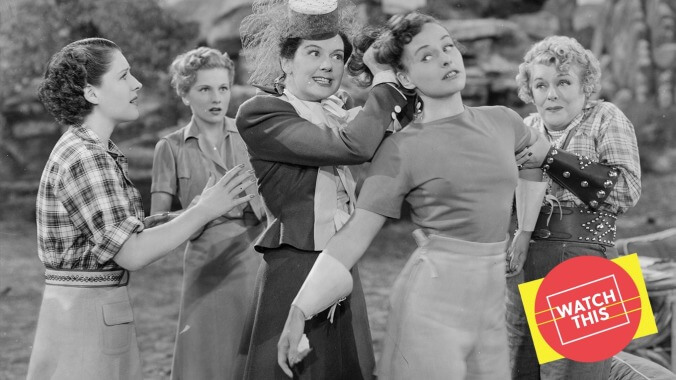The ultimate Hollywood “women’s picture” was the one that featured no men at all

Watch This offers movie recommendations inspired by new releases, premieres, current events, or occasionally just our own inscrutable whims. This week: With Wes Anderson’s The French Dispatch moving from July to October, we’re singling out other ensemble comedies to watch instead.
The Women (1939)
There were “women’s pictures” in the 1930s and ’40s—usually a tearjerker featuring someone like Barbara Stanwyck in a sticky romantic entanglement—but there was only one all-women picture. The Women boasted a cast of 135, with not a single man in the bunch; it was rumored that even the onscreen animals (a dog, several horses) were entirely female. It offered a fantastical view of a glittering, splendid, opulent life—full of ladies lunches, fashion pinnacles, and loads of servants—while exploring what happens to social sunbeam Mary Haines (Irving Thalberg’s young widow, Norma Shearer) when her (never seen) husband falls for the conniving Crystal Allen (Joan Crawford, on the crest of becoming the star of several “women’s pictures” of her own).
Women were instrumental behind the scenes, too. The movie was based on the hit play by future congresswoman and ambassador Clare Boothe Luce, with a screenplay by eventual Gentlemen Prefer Blondes scribe Anita Loos. George Cukor, who had just been fired from Gone With The Wind and had already helmed such female-forward films as Little Women and Camille, directed. Expertly guiding the performances, Cukor here justifies his reputation as a preeminent “women’s director.”
Early Oscar winner Shearer still held the public’s sympathy after Hollywood producer Thalberg’s untimely death of a heart attack a few years prior, making her perfect for the role of Mary, a blissfully happy wife and mother who has no idea that her husband is “stepping out.” With Shearer holding up the solid moral center, the rest of the cast was free to roam as broadly as possible, with Crawford displaying a methodical heartlessness, while Paulette Goddard plays the solid best-friend type and Joan Fontaine the kind of ignorant innocent she’d win the Oscar for portraying in 1941’s Suspicion.
No one, however, took more advantage of this liberty than Rosalind Russell, wearing Seussian hats and chattering even faster than she would in His Girl Friday the following year. Russell’s catty Sylvia reveals herself to be the type of “friend” who revels in horrible things happening to her closest confidantes. The movie curiously maintains that any marriage can survive the husband’s infidelity if the wife just lets the affair run its course, but Sylvia not only leads Mary to discover the affair, she pokes and prods her to confront Crystal in a stunning showdown at an exclusive fashion show (complete with a then-futuristic Technicolor segment). The Women delights in its biting dialogue; when Mary tells Crystal, “May I suggest, if you’re dressing to please Stephen, not that one. He doesn’t like such obvious effects,” Crystal replies, “Thanks for the tip. But when anything I wear doesn’t please Stephen, I take it off.”
The Women promised the chance to see the fairer sex “with their hair down and their claws out,” where as men suspected, they were just talking about their relationships anyway. (“The Women—and it’s all about men!” claimed the tagline.) The film pulled back the curtain on how some of those 1930s glamour girls got so beautiful. The opening spa sequence (reportedly styled after Elizabeth Arden) featured a stunning plethora of mud baths, sun lamps, exercise classes, and beauty treatments designed to roll away every wrinkle or line. In its way, The Women was as much an idealized fantasy as the Astaire-Rogers musicals of the same decade; at the end of the Depression, with World War II on the horizon, just how many women, even New York socialites, were able to make grooming their full-time job?
But those sumptuous ladies lounges and even the divorce ranch in Reno are only backdrops for the fizzy banter that whips into a conversational funnel cloud among this disparate crop of women. It’s worth turning the captions on just to catch every syllable of Russell’s 90 mph delivery. (“You remember the awful things they said about what’s-her-name before she jumped out the window? There. You see? I can’t even remember her name so who cares?”) Only Crawford matches her for intensity (“Can you beat that guy? He almost stood me up for his wife!”). Goddard, in the role that helped her break away from husband Charlie Chaplin’s shadow, offers plenty of salt-of-the-earth advice.
Throughout, Shearer’s emotional voyage remains engrossing to witness, as she states to her mother that in this modern age she and Stephen are equals even though from a financial standpoint, they’re anything but. Mary eventually realizes what she needs to do to get her life back on track, and 2020 audiences may wince at her ultimate declaration about the economies present in the relationships of the past, as she calls pride “the one thing a woman in love can’t afford.” Their official power rankings may have been a bit lopsided, but it’s still clear from watching The Women that the female sex is the one in charge, crafting beautiful facades as they pull all the strings that really matter.
Availability: The Women is available to rent or purchase digitally on Amazon, Google Play, iTunes, YouTube, and VUDU.